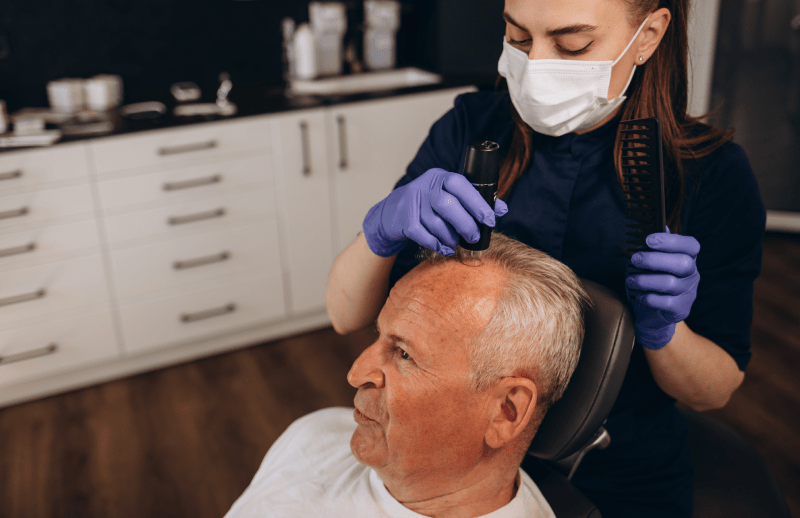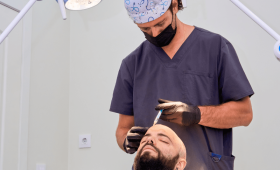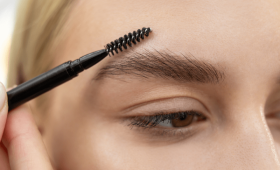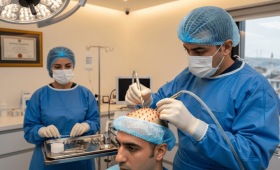What Is Hair Transplantation And How Does It Work?
Hair transplantation is a surgical procedure where healthy hair follicles are taken from donor areas, typically the back or sides of the head, which are genetically resistant to balding, and transferred to recipient areas where hair is thinning or completely lost.
This procedure is performed under local anesthesia, aiming for the follicles to continue growing in their new location. Essentially, it provides a natural and permanent solution by utilizing the body’s own hair. The success of the operation heavily relies on the quality of the donor area and the ability of the transferred roots to anchor and receive blood supply in their new environment. Utmost hygiene and precision are critical throughout this entire process.
Who Is A Suitable Candidate For Hair Transplantation?
Suitable candidates for hair transplantation are individuals who have an adequate supply of healthy donor hair, are in good general health, and have stabilized their hair loss process. Generally, individuals over the age of 20 who are experiencing male pattern baldness, or those who have lost hair due to trauma or burns, may be candidates. Those with chronic conditions such as diabetes or high blood pressure, or those taking blood thinners, must undergo a detailed preliminary examination. Having realistic expectations is also a crucial criterion for eligibility. It is essential to consult with an expert team to definitively confirm your suitability for the procedure.
How Is The FUE Technique Applied And What Are Its Advantages?
The FUE (Follicular Unit Extraction) technique is based on extracting hair follicles one by one from the donor area using specialized micro motors or manual punch tools. These harvested follicles are then implanted into micro-channels opened in the recipient area. The greatest advantage of this method is that it does not involve the use of a scalpel, meaning it leaves no stitches and no visible linear scarring. The recovery process is typically faster and less painful compared to older methods. It is an ideal solution for patients who wear their hair short or desire minimal scarring. Clinics in Turkey are well-known for applying the FUE technique with state-of-the-art equipment and high-level expertise.
What Is The DHI Technique And How Does It Differ From FUE?
The DHI (Direct Hair Implantation) technique is an innovative method where hair follicles are implanted directly into the recipient area using Choi implanter pens. Similar to FUE, the grafts are extracted one by one, but the canal opening and follicle implantation steps are performed simultaneously. In FUE, canals are opened in a separate stage after the roots are harvested. The key difference with DHI is that it minimizes the time the grafts spend outside the body, thereby preserving root viability and allowing for higher density transplantation. This makes it a particularly attractive option for patients who prefer not to fully shave their existing hair.
Which Preparations Should Be Made Before Hair Transplantation?
Before a hair transplant, it is essential to strictly follow the surgeon’s recommendations to prepare for the surgical procedure. Generally, patients are asked to stop consuming alcohol, smoking, and taking blood-thinning medications (like aspirin and certain vitamins) starting one week before the operation. Reducing caffeine intake and ensuring a good night’s sleep before the procedure are also important preparatory steps. You should wash your hair before the operation and avoid using styling products such as gel or spray. These preparations will directly influence both the success of the procedure and the comfort of your recovery period.
Is Pain Experienced During The Procedure?
Since the hair transplant procedure is performed under local anesthesia, patients typically do not feel any pain during the graft harvesting and implantation stages. There might be a slight stinging sensation when the anesthetic is initially administered, but this is short-lived. After the procedure, as the effects of the anesthesia start to wear off, you might feel some mild discomfort or soreness. This is usually easily managed with painkillers prescribed by your doctor. Most patients describe the entire experience as comfortable and relatively relaxed, often able to watch a movie or listen to music during the session.
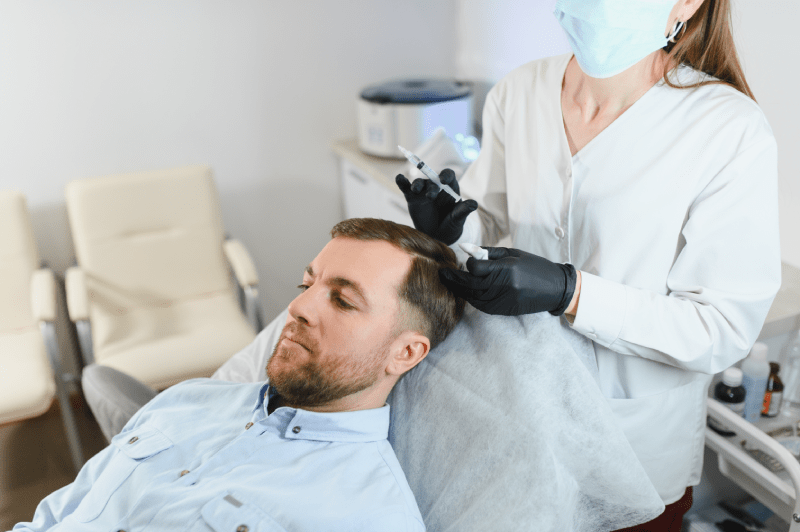
When Do Hair Transplant Results Start To Become Visible?
Achieving the full results of a hair transplant is a process that requires patience and usually takes between 12 to 18 months. The transplanted hairs will initially shed within the first few weeks (the shock loss phase), which is a normal and expected part of the process. New, permanent hairs begin to emerge around the third month. A noticeable change is usually observed by the sixth month, and the final result is largely established by the end of the first year. This gradual progression is a natural biological process and not a cause for concern, demonstrating the successful integration of the follicles.
What Is Shock Loss And When Does It Occur?
Shock loss is the temporary shedding of the transplanted hair follicles that typically occurs about two to eight weeks following the hair transplant operation. This condition is a stress reaction, part of the process of the follicles adapting to their new location, and is entirely normal. The hair root itself is not damaged; only the hair shaft above the skin surface falls out. Following shock loss, the roots enter a resting phase and subsequently begin to produce new, healthy hair strands permanently. This shedding is an indication of a successful transplant and should not be a cause for alarm or distress.
What Should Be Considered On The First Night After Hair Transplantation?
The first night after a hair transplant is vitally important for protecting the implanted grafts and ensuring they do not become dislodged. It is highly recommended to sleep on your back in an elevated and upright position, using a high pillow or neck pillow. You must strictly avoid rubbing the donor and recipient areas against the bed, pillow, or any surface. This friction can potentially damage the newly placed grafts. Furthermore, any special bandages or headbands provided by the doctor must be used exactly as instructed. The first 48 hours represent the most critical period for the survival and successful anchoring of the transplanted hair roots.
How Should Washing Be Done After Hair Transplantation?
The first wash is generally performed 48-72 hours after the operation, either at the clinic or under the supervision of your doctor. Subsequent washes should be done at home using the special lotion and shampoo provided by the clinic, strictly following the instructions. The lotion is gently applied to the recipient area and left for a period before being rinsed off with low-pressure, lukewarm water. Scrubbing or using fingernails is absolutely forbidden. Only gentle dabbing motions should be used on the scalp with the pads of the fingertips. This delicate washing process continues for approximately 10-14 days until all scabs have cleared.
Will There Be A Scar In The Donor Area?
Modern hair transplantation techniques, especially FUE and DHI, leave minimal and generally unnoticeable scarring in the donor area. Since the punch tools used in FUE are very small (typically 0.6 mm – 1.0 mm), the resulting marks are merely micro-dots that become completely hidden as the surrounding hair grows out. While older methods like FUT (Strip Technique) left a linear scar, the marks from contemporary preferred methods are barely discernible even with very short hair. This focus on minimal invasiveness is a key advantage of modern hair restoration.
When Can Sports Activities Be Resumed After Hair Transplantation?
It is mandatory to wait for a specific recovery period before resuming sports activities after a hair transplant. Non-strenuous activities, such as light walking, can generally be performed after the first week. However, for heavy sports, weightlifting, and swimming—activities that involve sweating or risk of impact/pressure on the scalp—it is generally necessary to wait for at least one month. Excessive sweating can increase the risk of infection, and strenuous activity can put undue stress on the newly implanted grafts, potentially causing damage.
Are The Transplanted Hairs Permanent?
Yes, the transplanted hairs are generally permanent. This is because the hair follicles used as the donor region, typically from the back and sides of the head, are genetically resistant to the DHT hormone (dihydrotestosterone), which is the primary cause of hair loss. When these resistant roots are transferred to their new location, they retain this characteristic and do not shed. This permanence is the fundamental principle that makes hair transplantation the most effective and long-lasting solution against hair loss, providing patients with confidence in their results.
What Is The Most Suitable Age Range For Hair Transplantation?
Although there is no definitive age limit for hair transplantation, most specialists recommend the age range of 25-65, where the pattern of hair loss has stabilized. Since hair loss may still be active in younger individuals (20-25), performing an early transplant might result in new areas of balding later on, requiring an additional procedure. If possible, it is best to wait until the hair loss pattern is clear and the full potential of the donor area can be assessed. However, this age range may be flexible for cases involving traumatic hair loss.
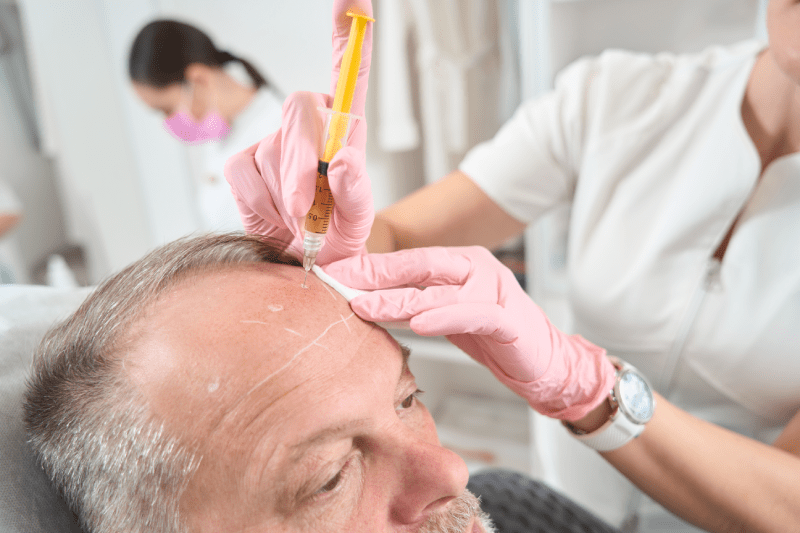
When Is Sexual Intercourse Safe After Hair Transplantation?
It is generally advised to abstain from sexual activity for the first 7-10 days following a hair transplant. The main reason for this recommendation is that sexual intercourse increases blood pressure and heart rate, which has the potential to cause bleeding in the scalp. Furthermore, sweating can increase the risk of infection in the newly treated areas. Most importantly, any physical contact or friction to the transplanted area during the first week could damage the newly implanted grafts that have not yet fully anchored in place.
How Should The Scalp Be Protected From The Sun After Hair Transplantation?
For the first few weeks, especially the first month after a hair transplant, the recipient area must be absolutely protected from direct sunlight. Sun exposure can cause discoloration (hyperpigmentation) in the transplanted area and damage the newly implanted grafts. When going outdoors, loose, comfortable hats or caps that do not put pressure on the surgical area should be worn. The use of sunscreen should only be initiated with the doctor’s approval, usually after the crusting process has completely finished to avoid chemical irritation.
When Can Alcohol And Smoking Be Resumed After Hair Transplantation?
Just as before the operation, abstinence from alcohol and smoking is mandatory after the hair transplant procedure. Generally, it is advised to avoid both alcohol and smoking for at least 10-15 days post-operation. Smoking severely restricts the flow of oxygen and nutrients to the hair follicles by narrowing blood vessels, which slows down the healing rate and reduces the graft survival rate. Alcohol can also thin the blood and interfere with medications, which can pose a risk during the recovery phase.
How Is The Required Number Of Grafts Calculated For Hair Transplantation?
The required number of grafts is determined by an experienced surgeon based on the degree of hair loss (often measured using the Norwood scale), the size of the recipient area, and the desired density. The balding area is meticulously mapped using high-resolution photographs and a physical examination. Specialists calculate the optimal graft count to both ensure a natural aesthetic result and preserve the donor area for potential future use. Accurate determination of the graft number is critical for both aesthetic success and the longevity of the donor hair supply.
Which Criteria Are Important For A Successful Hair Transplant?
A successful hair transplant means more than just hair growth; it also encompasses aesthetic criteria such as a natural appearance, adequate density, and a hairline designed to suit the patient’s facial features. Success depends on a high survival rate of the transferred grafts, the preservation of the donor area, and, most importantly, meeting the patient’s expectations. An experienced surgeon, a competent clinic team, the correct application of modern techniques, and comprehensive post-operative care are the keys to fulfilling these criteria and ensuring a high-quality outcome.
How Many Hours Does The Hair Transplant Procedure Take?
The hair transplant procedure usually takes a long time, depending on the number of grafts to be transplanted and the chosen technique (FUE, DHI, etc.). For a smaller session, the duration can vary between four to six hours, while large and comprehensive transplants may last up to eight hours. Breaks for rest, meals, and bathroom use are provided throughout the procedure to ensure the patient’s comfort. The length of the process stems from the team’s meticulous effort to place each root with precision and at the correct angles, which is an indicator of quality.
How Are Scabs On The Scalp Cleaned After Hair Transplantation?
Scabs that form on the scalp after a hair transplant are a natural part of the healing process and are generally cleaned gently between the 7th and 10th days after the operation. This cleaning should be done using the special lotion and shampoo provided, strictly following the doctor’s instructions. It is important to leave the lotion on for a period to soften the scabs, and then wash them off with very light massaging movements using the fingertips. You must absolutely avoid picking or forcefully removing the scabs, as this could damage the implanted grafts beneath them.
Which Medications Should Be Used After Hair Transplantation?
After a hair transplant, your doctor will typically prescribe pain relievers, antibiotics, and anti-swelling medications. Painkillers are used to alleviate any discomfort felt in the first few days, while antibiotics are used to minimize the risk of infection. In some cases, supplements like biotin, vitamin complexes, or topical products like Minoxidil may also be recommended to help strengthen the transplanted and existing hair. All medications and supplements must only be used as directed by your prescribing physician.
Which Season Is More Suitable For Hair Transplantation?
Theoretically, any season is suitable for a hair transplant, but each has its own advantages and disadvantages. While sun protection is essential during the summer months, wearing a hat is more comfortable in winter, though cold exposure must be managed. The critical factors, regardless of the season, are adhering to sun protection rules, avoiding excessive sweating, and maintaining strict hygiene. If you are considering getting a hair transplant in Turkey, mild seasons like spring and autumn might be preferred for travel comfort.

Can Hair Transplantation Be Repeated?
Yes, the hair transplant procedure can be repeated, provided there are sufficient healthy hair follicles remaining in the donor area. A second session may be necessary if the desired density is not achieved after the first procedure, if hair loss progresses in new areas, or if minor adjustments to the hairline are needed. It is generally recommended to wait at least 12 months after the initial operation for a second transplant to allow the donor area to fully heal and the results of the first implant to become completely clear.
Why Is Hairline Design Important?
Hairline design is the most critical factor determining the aesthetic success of a hair transplant and must be completely individualized for the patient. For a natural appearance, the hairline must be designed to suit the patient’s forehead, face shape, age, and muscle movements. A very sharp or very straight line will look artificial and unnatural. An experienced specialist will create a natural transition and a slight irregularity in the hairline design. This stage demonstrates the artistic skill of the surgeon and directly impacts the quality of the final result.
Is Itching Normal After Hair Transplantation?
Itching after a hair transplant is a common occurrence in both the donor and recipient areas and is a natural part of the healing process. This sensation is caused by the healing of nerve endings, the formation of scabs, and the beginning of new hair growth. However, scratching must be strictly avoided, as it can damage the newly implanted grafts or lead to infection. Moisturizing lotions, sprays, or antihistamines recommended by your doctor will help manage this common post-operative symptom effectively.
When Can Hair Be Cut After Hair Transplantation?
It is important not to rush the first haircut after a hair transplant. Generally, it is advised to wait at least one month for cutting with scissors and at least three months for cutting with a razor or clippers. The vibration and contact of a razor or clippers with the skin can harm the newly settled roots. The first few months are a critical period for the full anchoring and strengthening of the hair follicles, so following your doctor’s advice and waiting is the safest approach for your results.
Which Side Effects Can Be Seen After Hair Transplantation?
Mild side effects after a hair transplant are common and are usually temporary. The most frequently observed side effects include swelling (edema) of the scalp, redness, mild pain, numbness, and itching. Swelling typically subsides within the first few days, and redness usually disappears within a few weeks. Although rare, conditions such as infection or folliculitis (inflammation of the hair follicles) can sometimes develop, but these are generally easily treatable with antibiotics if detected promptly.
How Is Swelling And Edema Reduced After Hair Transplantation?
Swelling (edema) is common after a hair transplant, especially around the forehead and eyes, and typically lasts for a few days. The most important method recommended by doctors to reduce swelling is sleeping with the head in an elevated position for the first 48 hours. The anti-swelling medications prescribed by the doctor should be used regularly. Applying a cold compress to the forehead can also help reduce the swelling, but the cold compress must absolutely not touch the transplanted area directly to avoid damage.
How Should Nutrition Be After Hair Transplantation?
Nutrition after a hair transplant is crucial for supporting the healing process and helping the new hair follicles strengthen. It is recommended to consume foods rich in protein (eggs, fish, chicken) and foods containing essential micronutrients like zinc, iron, and B vitamins (especially Biotin), such as green leafy vegetables and nuts. Drinking plenty of water maintains the body’s hydration level and supports blood circulation. Foods with anti-inflammatory properties can also contribute significantly to quicker and healthier healing.
How Is Travel Planning Related To The Hair Transplant Process?
A hair transplant generally involves a process lasting a few days (consultation, operation, first wash). Therefore, travel planning is important for patients coming from out of town or abroad. Patients traveling by plane, in particular, need to ensure they travel comfortably without putting pressure on the scalp. If you are traveling to leading medical tourism centers like Turkey, firms such as Cure Holiday can simplify your experience by offering accommodation, transfers, and comprehensive package management all in one place.
What Ensures The Natural Appearance Of Hair Transplant Results?
Three fundamental factors are critical to achieving a natural result: correct hairline design, correct graft direction, and correct density. The hairline must be designed to be slightly sloped and irregular (zig-zag) to suit the patient’s facial features and age. Furthermore, implanting the grafts by adhering to the natural angle and direction of the original hair growth ensures the hair has a natural flow when combed. All these elements are only truly possible with a highly experienced and skilled medical team.
When Do Red Dots Disappear After Hair Transplantation?
Small red dots form in the recipient area immediately after the hair transplant operation at the points where the grafts were implanted. This is a natural consequence of the micro-channels being opened, and these points scab over time. After the crusting process is complete (usually 10-14 days) and the scabs are gently removed, the redness begins to gradually subside. The complete disappearance of the redness can take anywhere from a few weeks to a few months, depending on the individual’s skin type and healing rate.
What Is Hair Transplant Guarantee And What Does It Cover?
A hair transplant guarantee is often a commitment offered by clinics, providing a free touch-up session or a refund if a certain percentage (e.g., 90%) of the transplanted hair follicles fails to grow. This guarantee is usually conditional on the patient strictly following all of the doctor’s aftercare instructions. The scope can vary from clinic to clinic, so it is important to carefully read the terms of the agreement. Reputable institutions in Turkey that are confident in their successful outcomes often provide similar comprehensive assurances to their international patients.
What Other Hair Treatments Are Available Besides Hair Transplantation?
Aside from hair transplantation, various non-surgical treatments are available to slow down hair loss and strengthen existing hair. These primarily include medication treatments like Minoxidil and Finasteride, which are clinically proven to slow hair loss. Furthermore, treatments like PRP (Platelet-Rich Plasma) and Mesotherapy, where vitamins and minerals are injected into the scalp, are also popular. These treatments can be particularly useful as supportive therapies to preserve existing hair after a hair transplant procedure.
Why Should Turkey Be Considered For Hair Transplantation?
Turkey has become a global center for hair transplantation due to the high-quality standards, state-of-the-art equipment, world-experienced surgeons, and the extraordinary price advantage it offers compared to Western countries. Turkish clinics have gained vast expertise by treating thousands of international patients annually. Moreover, they offer comprehensive packages that combine the hair transplant process with a comfortable travel experience. Cure Holiday can assist you in accessing these quality and cost-effective treatment options by taking care of all your travel arrangements.
What Is The Purpose Of Blood Tests Done Before The Procedure?
Blood tests performed before the procedure are vital for checking the patient’s general health status and determining if there are any contraindications (conditions that prevent the procedure) that could affect safety. These tests specifically check for infectious diseases such as HIV, Hepatitis B and C, assess the blood’s clotting time, and screen for other conditions that might pose a risk during anesthesia. Ensuring all findings are within normal ranges is a fundamental requirement for the procedure to be performed safely and successfully.
Why Is Keeping The Head Elevated Important After Hair Transplantation?
Keeping the head in an elevated position after a hair transplant is a critical precaution, especially during the first 48-72 hours, to control the formation of swelling (edema). The elevated sleeping position helps the fluid accumulated on the scalp drain downwards due to gravity, preventing the swelling from descending into the forehead and eye areas. This simple yet highly effective method significantly speeds up the recovery process and substantially increases the patient’s comfort level during the initial healing phase.
What Is Done If There Is Insufficient Hair In The Donor Area?
Insufficient healthy hair follicles in the donor area present one of the biggest challenges for hair transplantation. In such cases, hair roots can be harvested from alternative donor regions, such as the chest or beard (BHT – Body Hair Transplant), and implanted. However, because body hair has a different growth cycle and structure than scalp hair, this option is considered a last resort, and the results may not be as natural or dense as those achieved using scalp follicles.
When Can A Hat Be Worn After Hair Transplantation?
The timing for wearing a hat after a hair transplant depends on the type of hat and the pressure it exerts. For the first 10 days, tight hats that directly touch or put pressure on the recipient area must be absolutely avoided. Generally, after the bandage is removed on the third day, a loose-fitting hat that rests above the implanted area without contact may be permitted. Your doctor will detail the most suitable type of hat and the duration it can be worn to ensure the new grafts remain protected.
Are Nutritional Supplements Necessary After Hair Transplantation?
While nutritional supplements are not strictly mandatory after a hair transplant, they are generally recommended to support the healing process and help the new hair grow in stronger. Specifically, supplements critical for hair health, such as Biotin, Zinc, B Vitamins, and L-cysteine, may be used under a doctor’s recommendation. These supplements contribute to the nourishment of the hair follicles, potentially increasing the survival rate and improving the quality of the hair that emerges after the shock loss phase.
Is PRP Treatment Beneficial After Hair Transplantation?
Yes, PRP (Platelet-Rich Plasma) treatment is a frequently recommended supportive method after a hair transplant to accelerate healing and enhance the quality of the transplanted hair follicles. PRP involves injecting plasma, which is enriched with growth factors and derived from the patient’s own blood, into the scalp. These growth factors stimulate the newly implanted follicles, increase blood circulation, and help speed up the healing process, resulting in thicker and healthier hair growth.
Which Hair Products Should Not Be Used After Hair Transplantation?
In the first few months after a hair transplant, you must strictly avoid hair sprays, gels, styling products, and shampoos containing harsh chemicals, alcohol, or parabens. For the initial washes, only mild, hypoallergenic products with a low pH, provided or recommended by the clinic, should be used. Chemical-laden products can irritate the sensitized scalp and increase the risk of infection. For chemical procedures like hair coloring or perming, it is generally necessary to wait for at least six months for the scalp to fully recover.
How Long Does It Take For Hair Transplant Results To Fully Mature?
The complete maturation of hair transplant results takes between 12 to 18 months, depending on individual healing speed and the size of the implanted area. By the end of the first year, most of the transplanted hair will have grown in, and a significant density will have been achieved. However, the hair strands need time until the eighteenth month to fully thicken, take their final shape, and achieve their natural flow. This maturation period must be patiently awaited to see the ultimate, permanent result of the procedure.
This detailed guide was prepared to illuminate your hair transplant journey. Remember that Turkey is a leading destination for a high-quality, globally standardized, and much more affordable hair transplant experience.
If you would like to learn all the details of the hair transplant process, including accommodation and travel arrangements, and create a personalized treatment plan, you can confidently contact Cure Holiday. They will be by your side every step of the way with tailored solutions.
